|

 Up
Up 
 The
The
Smithsonian
Contract

(You are here.)
 Down
Down




  Need
to Need
to
find your
bearings?
Try
these
navigation aids:
If
this is your first
visit, please stop by:
Something
to share?
Please:



|
|
Available in Française, Español, Português, Deutsch, Россию,
中文,
日本, and others.
 ne
of the many bones of contention between historians who believe the
Wright brothers were the first to make a controlled and sustained
powered flight and those who put forth other candidates is a
contract between the Smithsonian Institution and the Wright Estate.
Dated 23 November 1948, almost a year after Orville Wright's death,
the agreement was the direct result of the
long feud between Orville
Wright and the Smithsonian. The two disagreed whether the Wright
brothers or
Samuel P. Langley, the former Secretary of the Smithsonian,
deserved the credit for having developed the first successful
aircraft. The
resolution of this disagreement defined the meaning of a successful
airplane. ne
of the many bones of contention between historians who believe the
Wright brothers were the first to make a controlled and sustained
powered flight and those who put forth other candidates is a
contract between the Smithsonian Institution and the Wright Estate.
Dated 23 November 1948, almost a year after Orville Wright's death,
the agreement was the direct result of the
long feud between Orville
Wright and the Smithsonian. The two disagreed whether the Wright
brothers or
Samuel P. Langley, the former Secretary of the Smithsonian,
deserved the credit for having developed the first successful
aircraft. The
resolution of this disagreement defined the meaning of a successful
airplane.
Samuel Langley had been an active experimenter
with mechanical flight since the 1880s. In 1896, he flew two large
steam-powered aircraft he called "aerodromes" repeatedly for
sustained flights of up to 4000 feet (1219
meters). The aircraft were unmanned and uncontrolled, but the
flights attracted much attention. Two years later in 1898, the War
Department gave Langley $50,000 to create an aerodrome capable of
carrying a man. Langley attempted to fly his "Aerodrome A"
twice on 7 October 1903 and 8 December 1903 with
Charles Manly as a very brave pilot. On both occasions Aerodrome A
slid into the Potomac River after being catapulted from a houseboat.
These were extremely embarrassing moments for the Smithsonian and
the War Department, both of whom were ridiculed mercilessly in the
press. All this took place just before the Wright brothers succeeded
in flying on 17 December 1903.
In 1906, the Wright brothers were granted a patent for a control
system that could steer an aircraft in three axes – roll, pitch, and
yaw. It was not, as many people believe, a patent on the powered
airplane. The concept of the fixed-wing airplane had first been
proposed in 1799.
Alphonse Penaud created a rubber band-powered model which flew
successfully in 1871, possibly the first sustained powered airplane
flight. But like Langley's later flights, it too was uncontrolled.
The first experimenter to successfully control an aircraft was
Otto Lilienthal, who made glider flights between 1891 and 1896.
However, he controlled his craft by shifting his weight, effecting
roll and pitch only. Full three-axis control wasn't achieved until
1902 when the Wright brothers flew a glider with aerodynamic control
surfaces. This is what they patented. They married their control
system to a powered aircraft in 1903 to make the first controlled
and sustained powered flights.
It was this three-axis aerodynamic control system that other
experimenters copied. In 1909, the Wright brothers launched patent
suits to protect their intellectual property and their most
persistent opponent was Glenn Curtiss. The courts ruled against
Curtiss in 1913 and 1914, but he appealed on the grounds that other
aircraft could have flown before the Wright Flyer. At the same time
Charles Walcott, who had taken over the Smithsonian Institution when
Langley died, was helping the Smith to rebuild its reputation after
the Aerodrome fiasco. The two men realized that flying the Aerodrome
would solve both their problems, and the Smithsonian loaned Curtiss the
remains of Langley's Aerodrome A. He rebuilt the aircraft
making many changes to improve structural strength, lift, power, and
controllability.
On 28 May 1914, Curtiss made a few hop-flights off
the surface of a lake. This ruse had no effect on the patent suit,
but it was balm for the bruised egos at the Smithsonian. Upon
getting the Aerodrome A back from Curtiss, they proudly
displayed the aircraft at the Arts and Industries Building with a plaque that claimed it
was the first airplane "capable" of manned flight.
Orville was livid and
thus began a feud that he eventually won in
the courts of public opinion. He sent the 1903 Wright Flyer –
considered a national treasure by many – to England to underscore
the ridiculous position of the Smithsonian. Even if the Aerodrome
A had been "capable" of flight (and later studies would show
that it wasn't), it simply hadn't flown in its original condition.
To bring the Flyer back, Orville demanded that the Smithsonian
apologize and admit the error of their ways.
This they finally did
in 1942, and in 1943 President Franklin D. Roosevelt, with Orville's
assent, announced the Flyer would be returning to America. Unfortunately there was a world war on at the time and no
one got around to packing up the airplane and sending it back to
America until Orville was deceased.
Harold Miller, the husband of Orville's niece and the executor of
his estate, thought that something should be done to prevent the
Smithsonian from backpedaling. The feud seemed to be over, but it
was still fresh in everyone's memory. A change of Secretaries at the
Smith and it might be back on. So Miller, on behalf of the Wright
Estate, insisted on an agreement with the Smithsonian. The Wright
Flyer would continue to be used as leverage on the side of the
angels. If the Smith ever identified another aircraft as the first
to make a controlled, powered manned flight, the Wright heirs could
reclaim this national treasure.
The full text of this agreement is included at the end of this
web page. It is a challenging piece of legalese, a source of more
obfuscation than clarification for those who don't speak the
language. But if you parse the sentences and paragraphs, the
Smithsonian and the Wright Estate agreed on these points:
- The Estate of Orville Wright agrees to sell the 1903 Wright
Flyer to the United States
(represented by the Smithsonian) for $1.
- In return, the United States guarantees the aircraft to be
displayed prominently in the nation’s capital and to be
identified as the first heavier-than-air flying machine in which
men made a controlled and powered flight.
- The airplane is to be valued at $1 for tax purposes.
- Should the United States not prominently display the
airplane, display it without the agreed-upon identification, or
identify another airplane as being capable of controlled and
powered manned flight before December 17, 1903, the ownership of
the airplane reverts to the Estate.
- Additionally, if the airplane is valued at more than $1 and
the Estate is assessed for taxes, the United States will pay those
taxes. If it does not, the title reverts.
- If the United States forfeits its title to the airplane for
any of these reasons, it has five years to comply with the
agreement to regain title.
This was not a clandestine conspiracy as some have claimed. It
was entered in the public record when the court of Montgomery County,
Ohio probated the Wright estate after Orville's death and it
remained public record from that point on. As far as the Smithsonian
was concerned, these sorts of agreements are common between museums and
donors. The folks who own the Hope Diamond certainly didn't lend it
to the Smithsonian with the understanding it might someday be
hidden away in the basement. It's a safe bet that the donors and the
Smith have an understanding that it will be prominently displayed,
it will be properly identified, and that the valuation of the gem
will not result in unwarranted taxes.
It's also a common policy to keep these agreements from public
eyes to protect the privacy of the donors, although this particular
agreement was always public record.
Still, the Smithsonian did not advertise it – not because of any
conspiracy, but because it was evidence that the Smithsonian had
behaved badly in trying to credit Langley and his Aerodrome A
with honors they did not deserve. But when Senator Lowell Weicker
requested a copy for Whitehead supporter William O'Dwyer, the
Smithsonian provided it. The agreement was showcased in O'Dwyer's
1978 book, History by Contract. There was no need for
O'Dwyer or Weicker to employ the Freedom of Information Act, as has
been erroneously reported. This is still the case – the Smith
released one to us just for the asking. This is in the
interest of the public, the Smithsonian, and the Wright brothers.
Those who take the time to read it fail to find evidence of a
conspiracy to hide the truth. Most of it is mundane. The clause that
seems to give the most offense to those who would challenge the
Wrights' primacy is Paragraph 2(d):
"Neither the Smithsonian Institution or its successors nor
any museum or other agency, bureau or facilities, administered
for the United States of America by the Smithsonian Institution
or its successors, shall publish or permit to be displayed a
statement or label in connection with or in respect of any
aircraft model or design of earlier date than the Wright
Aeroplane of 1903, claiming In effect that such aircraft was
capable of carrying a man under its own power in controlled
flight."
It seems ironclad, but it lacks clarity. The word "capable" of
course is a direct poke at the Smith's attempt to promote the
Aerodrome A. But the writer does not define "controlled flight"
as millions of pilots came to understand it – three-axis control.
And there is nothing here that clearly says the aircraft must have
sufficient power to sustain flight. Technically, a glider would
qualify using Wilbur's own argument that soaring machines have a
"gravity engine" for power. There are loopholes here you could fly
an airplane through – a poorly-controlled, underpowered airplane.
Furthermore, when read in context with the remainder of the
agreement, this does not prevent the Smithsonian from investigating
alternate versions of aviation history. It simply says that should
the Smithsonian take the position that someone other than the Wright
brothers made a controlled and powered flight before 17 December
1903, they should be prepared to forfeit the airplane.
It's also worth noting that this agreement was struck in 1948.
For the first half of the twentieth century, the Smithsonian was
free to endorse any inventor or any airplane they deemed first to
fly. There was certainly enough time to investigate other claims as
they came to light. For example, there were 13 years between the
time that Randolf and Phillips published the story of Gustave
Whitehead in the January 1935 edition of Popular Aviation and
the signing of the agreement, during which time the story was
investigated by Harvard University and found wanting.
Furthermore from 1929 on, the Guggenheim Chair (top dog in the
Aviation History section) of the Library of Congress was occupied by
Albert F. Zahm, a man who had been highly critical of the Wright
brothers since he testified against them in the patent suits of
1909-1913. Zahm actively sought information that would negate the
Wright brothers' accomplishments. During the end of his career, he
even offered a reward for photographic evidence that would prove the
Wrights weren't the first to fly. Had he found anything; it
certainly would have been passed to the Smithsonian before the
agreement was signed.
All this nitpicking aside, the agreement is a deterrent. Even if it
were someday proved that some earlier airplane made a sustained and
controlled flight before the Wright Flyer, the Flyer would remain a
national treasure. History has long established that the succession
of Wright experimental aircraft built between 1899 and 1905 gave
birth to aviation. And no one disputes that it was the Wrights who
developed the basic skill set needed to pilot an aircraft with
three-axis controls, and then taught these skills to others. If
other experimenters beat the Wrights to the punch, they did not
effectively communicate their accomplishments. Regardless of who
flew first, every successful aircraft in the air today traces its
lineage back to the 1903 Wright Flyer. That would be difficult for the
Smithsonian to forfeit, as Tom Crouch, Senior Curator of the Smithsonian's
Air & Space Museum, said in press release on 15 March 2013:
"The contract remains in force today, a
healthy reminder of a less than exemplary moment in Smithsonian
history. Over the years individuals who argue for other
claimants to the honor of having made the first flight have
claimed that the contract is secret. It is not. I have sent many
copies upon request. Critics have also charged that no
Smithsonian staff member would ever be willing to entertain such
a possibility and risk losing a national treasure. I can only
hope that, should persuasive evidence for a prior flight be
presented, my colleagues and I would have the courage and the
honesty to admit the new evidence and risk the loss of the
Wright Flyer. "
We hope so, too, and would applaud their grace under immense
pressure.
However, perhaps it's time for a change. Langley-inspired politics are no
longer a threat to the Wright legacy. There has been no credible
challenge to the Wright's title as the first to make a controlled
and sustained powered flight for over a century, and there is none
now despite recent chest thumping about analysis of photos within
old photos. A joint statement from the Smithsonian and the Wright
heirs saying that they will consider amending the agreement should
someone present credible evidence of ante-Wright flight would affirm
public confidence in what most scholars know to be plain,
unvarnished aviation history. It would diffuse one of the most
often-used arguments against the Wrights' historic status and would
send the conspiracy theorists scrambling for another conspiracy.
More Information
|
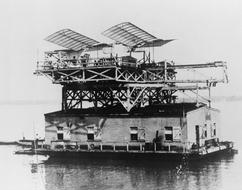
Langley's Aerodrome A
mounted on a catapult atop a houseboat afloat in the Potomac River
near Quantico, VA.
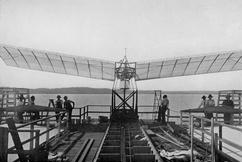
Workmen assemble the Aerodrome A
on its catapult. The wings were considered so fragile, they couldn't
be put in place unless the wind was below 5 mph (8 kph).
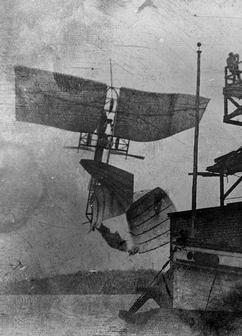
The Aerodrome A drops into
the river just after it was launched on 8 December 1903. The rear
set of wings collapsed immediately after it left the catapult.
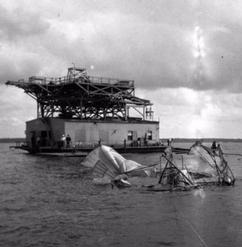
The Aerodrome A lies
crumpled on the river. Manly, who was wearing a cork life vest, was
trapped under the wreckage briefly but escaped unharmed.
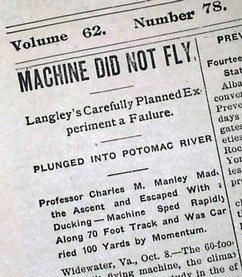
Both of Langley's attempts to fly made the newspapers worldwide.
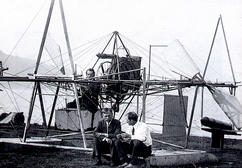
Glenn Curtiss in the newly rebuilt cockpit of the
Aerodrome A. Albert Zahm
(front left) and Charles Manly (front right) are seated on a
pontoon.
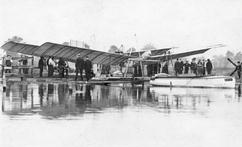
The modified Aerodrome A is
towed onto Lake Keuka near Hammondsport, NY. Read more about the
1914-1915 test flights
HERE.
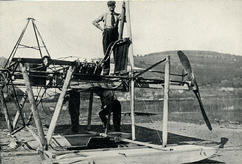
Among the many modifications made to the
Aerodrome A was the addition
of a Curtiss V-8 engine and a modern propeller. However, it did make
several flights with the original Manly-Balzer engine and Langley
propellers.
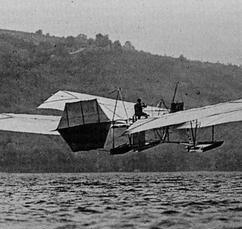
Three separate pilots flew the modified
Aerodrome A – Glenn Curtiss,
Elwood Doherty, and Walter Johnson. The best flight was about 20
miles
(32 kilometers) in a straight line, although with the Manly-Balzer
engine the aircraft could only make unsustained hop-flights of
150-200 feet (46-61 meters).
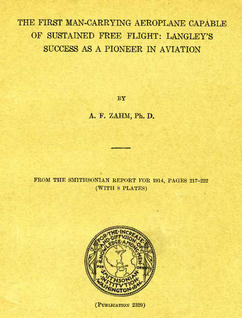
The cover of the 1915 Smithsonian report on Curtiss' test flights of
the Aerodrome A, written by
Alfred Zahm. Zahm mentioned the modifications, but gave the distinct
impression that these were made after the Aerodrome had first been
flown in its original configuration.
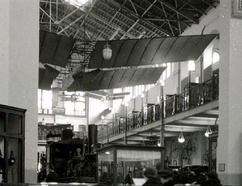
Aerodrome A was returned to
its original configuration (without modifications) and installed in
the Smithsonian in 1918. The plaque read: "Original Langley Flying
Machine, 1903. The first man-carrying airplane in the history of the
world capable of sustained free flight..."
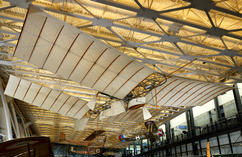
Today, Aerodome A is on
display at the Smithsonian Air & Space Museum Annex at the Dulles
Airport in Virginia.
|
|
|
|
The full text of the contract between the Wright Estate and the
United States of America (as represented by the Smithsonian
Institution):
AGREEMENT
THIS AGREEMENT made by and between
HAROLD S. MILLER and HAROLD W. STEEPER as Executors of the Last Will
and Testament of Orville Wright, deceased, hereinafter called the
Vendors, Parties of the First Part, and THE UNITED STATES OF
AMERICA, hereinafter called the Vendee, Party of the Second Part,
WITNESSETH:
WHEREAS there is included in the
residuary estate of Orville Wright the Wright Aeroplane of 1903,
invented and built by Wilbur and Orville Wright and flown by them at
Kitty Hawk, North Carolina on December 17, 1903, and
WHEREAS it is in the public interest that said plane be preserved
for all time and made available as a public exhibit in an
appropriate place and under proper auspices, and
WHEREAS the Probate Court of Montgomery
County, Ohio, having jurisdiction over the administration of said
estate, after full hearing in a proceeding to which all persons and
institutions having any interest under the will of Orville Wright
were parties and had submitted themselves to the jurisdiction of the
Court, has officially found that the known wishes of Orville Wright
will be carried out and the highest and best interest of the estate
will be served by recognizing the public interest and has
accordingly authorized and directed the Vendors to enter Into this
Agreement,
NOW, THEREFORE, THIS AGREEMENT
WITNESSETH;
1. For the consideration hereinafter set
forth the Vendors agree to sell and do hereby sell to the United
States of America, and agree to deliver to the United States
National Museum, Washington, D.C., within the current fiscal year
ending June 30, 1949, and subject to the terms of this Agreement,
the original Wright Aeroplane of 1903.
2. In consideration thereof the Vendee agrees to pay to the
Vendors the sum of One ($1.00) Dollar in cash and to comply with the
following requirements:
(a) Said aeroplane is to be displayed
in a public museum exhibit in the Metropolitan Area of the United
States National Capitol only, and except as hereinafter provided in
paragraph (b) to be housed directly facing the main entrance in the
fore part of the North Hall of the Arts and Industries Building of
the United States National Museum. It shall never be removed from
such public exhibition except as may be required temporarily for
maintenance and protection.
(b) If the proper authorities of the
Smithsonian Institution or its successors (acting for the United
Status of America) at any time in the future desire to remove said
aeroplane to any other building in the Metropolitan Area of the
national capital, such removal shall be permitted on the following
conditions:
(1) That the substituted building shall
have equal or better facilities for the protection, maintenance and
exhibition of the aeroplane.
(2) That the Wright Aeroplane Of 1903
be given a place of special honor and not intermingled with other
aeroplanes of later design.
(3) That such building be not a
military museum but be devoted to memorializing the development of
Aviation.
(c) There shall at all times be
prominently displayed with said aeroplane a label in the following
form and language:
“The Original Wright
Brothers' Aeroplane
The World's First Power-Driven Heavier-than-Air Machine
In Which Man made Free, Controlled, and
Sustained Flight
Invented and Built by Wilbur and Orville Wright
Flown by Them At Kitty Hawk, North Carolina
December 17. 1903
By Original Scientific Research the Wright Brothers discovered
the Principles of Human Flight
As Inventors, Builders and Flyers They Further Developed the
Aeroplane
Taught Man to Fly and Opened the Era of Aviation.
Deposited by the Estate of Orville Wright.”
“’The first flight lasted only twelve
seconds, a flight very modest compared with that of birds, but it
was nevertheless the first in the history of the world in which a
machine carrying a man had raised Itself by its own power into the
air in free flight, had sailed forward on a level course without
reduction of speed, and had finally landed without being wrecked.
The second and third flights were a little longer, and the fourth
lasted 59 seconds covering a distance of 852 feet over the ground
against a 20 mile wind.’
Wilbur
And Orville Wright
(From Century Magazine, Vol. 76, September 1908, p. 649)”
(d) Neither the Smithsonian Institution
or its successors nor any museum or other agency, bureau or
facilities, administered for the United States of America by the
Smithsonian Institution or its successors, shall publish or permit
to be displayed a statement or label in connection with or in
respect of any aircraft model or design of earlier date than the
Wright Aeroplane of 1903, claiming In effect that such aircraft was
capable of carrying a. man under its own power in controlled flight.
3. The title and right of possession to be
transferred by the Vendors hereunder shall remain vested in the
United States of America only so long as there shall be no deviation
by the Vendee from the requirements in the foregoing paragraph, and
only so long as neither the Estate of Orville Wright nor any person
having an interest therein is required to pay and does bear without
indemnity an estate or inheritance tax, assessed by the State of
Ohio, the United States or any other taxing authority, based upon a
valuation of property of the Estate which includes said aeroplane
at a value in excess of One ($1.00) Dollar.
4. Upon the failure of the Vendee to remedy any
deviation from the requirements set forth in paragraph 2, within
twelve months after written specification thereof shall have been
given to the Smithsonian Institution on behalf of the United States
or upon (a) the final assessment of any state or federal
inheritance, succession or estate tax whereby the Estate of Orville
Wright or any person or persons having an interest therein shall be
required to pay a higher tax by reason of a valuation of said
aeroplane for tax purposes in excess of One ($1.00) Dollar, and (b)
the omission of the United States or others on behalf of the United
Slates within twelve months of written notice of the final
assessment by the person assessed to provide for the payment thereof
by appropriations or otherwise, title to and right of possession of
said aeroplane shall automatically revert to the Vendors, their
successors and assigns.
5. In the event of a termination of title in the
United States by reason of an omission on the part of the United
States to provide for that In the event of a termination of title in
the United States by reason of an omission on the part of the United
States to provide for the payment of a tax assessment a aforesaid,
the United States shave have the option to repurchase the plane at
any time with five years of the tax payment by reimbursing the
taxpayer in the amount paid with interest thereon at six per cent
from the date of payment. Upon the exercise of such option, this
Agreement, in all of its terms shall automatically again become of
full force and effect.
Witness the due execution thereof here in duplicate this 23rd
day of November, 1948.
(signed)
Harold S. Miller
Harold W. Steeper
Executors of the Estate of Orville Wright, deceased;
UNITED STATES OF AMERICA
BY A. Wetmore
Secretary of the Smithsonian Institution
|
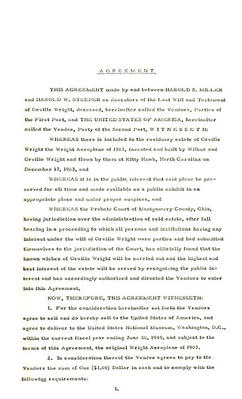
Page 1 of the original contract.
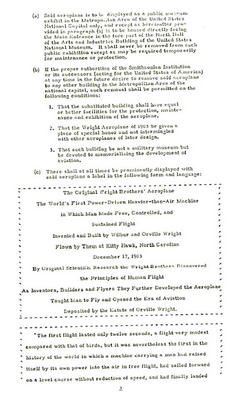
Page 2.
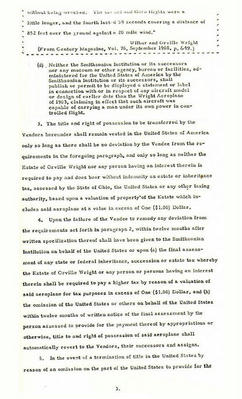
Page 3.
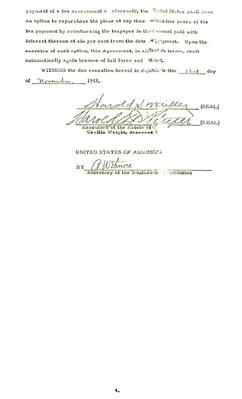
Page 4.
|